
At the end of a four or five day class, my students will be exhausted (and so will I!). Most of them will have spent the entire time working on the main part of their image: the person, the animal, the object, whatever it is they have chosen as their subject. Regardless of how far they got on their main image, or whether they will finish it in class, I have to give a talk sometime during the week about backgrounds.
I usually wait until day three—after they’ve had a chance to digest some of what I’ve introduced them to. I don’t wait until too close to the end—say, day four—because sometimes backgrounds are integral to the main image—a tractor in a farmyard, a flower on a bush, a fish in a coral reef. Even if the main image—their grandchild, their cape buffalo, their sea turtle—is independent from the background, it’s going to have to be addressed eventually.
Questions about backgrounds come in two main categories:
How do I do it?
How do I choose?
The first is a technical question easily answered. The second is sometimes more challenging and requires the student to access their creativity.
Backgrounds: How do I do it?
There are at least two ways for constructing a background.
The first way is to simply cut away the the foundation fabric from around the main image so that it can be placed on whatever fabric you are auditioning. (See Quilt Stories: Surprise Me for an example.) The advantage of this of course, is that you’ll be able to see immediately how it looks. Working this way, one could choose to use a single piece of fabric (whole cloth) as a background (such as I did with “Gombessa“) or one could also decide to construct a background from large, rectangular pieces of fabric—think of boxes or frames. See the examples based on my Serendipitous Sea Turtle pattern below.
This turtle is still in progress, but it’s pretty close to done, close enough so I can start looking at backgrounds. I’ve created it on a foundation fabric, then as you can see in the second picture, I’ve cut it away from the foundation so it can be auditioned with various backgrounds. See below.
The upper left version had way too busy of a print, even though as I was working on the turtle, I had it in mind as a potential background. However, I did like how the orange looked, so it gave me a color direction to explore. The upper right version had similar problems. The darker values of the greens were a bit close to the values in the turtle. If I wanted the turtle to blend in and out of its environment, it wouldn’t be a bad option. The lower left, while red-orange could provide a good contrast, it did seem to be too dark overall. Finally I was happiest with the last option. This orange version provided good contrast with the turtle. It’s horizontal stripes also contrast and therefore help to highlight the verticalness of the turtle. However, for my taste it was still a little too plain. So…
… adding a central band of a similar color but a contrasting print helps to jazz it up a bit. I think this will be my final choice for background. For now.
Here’s another example of a way to keep the background simple, but to add more interest to it.
This little fish (about 12 inches long) was created separately on the foundation fabric, then cut out and placed on a background created for it—still in the same cut and glue collage process. The aqua fabric creates a border around a lighter inner fabric. It’s this inner box that provides the contrast for the fish, otherwise the aqua would be too close in value and the fish would blend with the background. The triangles are added as ornamentation and to bring color and extra interest into the otherwise empty corners.
The same fish (my “Winged Butterfish” design available here), but in different colors and with a completely different background solution. This introduces the second way of constructing a background—to keep collaging onto the foundation. This lends itself to be more organic and freeform, and as you see in this case, still showing off the fish nicely.
It’s not necessary and sometimes not advantageous to cut the image away from the foundation fabric—it may be too complex or too big—then you simply continue collaging into the background. (Remember to leave the edges of the main image loose—not glued—so you can slide background fabric underneath.) Most of my quilts are done this way and I find this way of working to be more customizable.
Say you have a turtle or fish made up of greens and reds in a large variety of fabrics of many different values. You want the background to be made up of different shades of blue. By collaging the background around the image you can be very particular about which value of blue gets placed where. Most of the time it will be a case of highlighting the main image rather than having it blend in with the background. You would likely place the darkest blues against the lightest areas of the image and vice versa.
The two turtles below both have collaged backgrounds. The first might not look collaged, but there are darker and lighter areas of different fabrics. I avoided placing the lightest value fabrics close to the turtle, which might have caused it to blend in. (Plus, I wanted to work in my baby turtle fabric without being so obvious about it!) For the second, I knew I wanted some nighttime “sky” fabric to set off my bright “rainbow” turtle. The moon, star, and “spiral galaxy” (in my mind anyway) batiks I found in my stash fit the bill perfectly. The big ol’ flowers were a bit of a why not? afterthought. They were originally leftovers from the leaves I cut to go around the shell, but if I just pretend they’re “planets,” they now fit the theme as well.
Collaged backgrounds from multiple fabrics are now my favorite way of working. It encourages more creativity and serendipity. Rather than simply building a box or frame to put the image in, the opportunity arises to do something truly unique.
Which brings up another issue: How do you decide what the background should look like?
Backgrounds: How do I choose?
Okay, so when some students finish their main image they’re just ready to be done. The simplest background is just fine with them, being little more than a frame. And that’s okay. A piece of whole cloth or a simple box construction and they’re finished.
Other students, however, strive for something more ambitious and that’s when it can become overwhelming.
If you aren’t using a whole cloth or boxy background, the choices become infinite. And the infinite is scary. The way to defeat the infinite is with the particular. What is the particular story of this image?
When a student in class is struggling with her background, I ask questions in order to draw out the story behind the piece: What’s the subject? Where is the subject? What is it doing? Why did you choose this subject? What’s important about the subject?
The answers to these questions almost always lead us to our backgrounds. For example, let’s look at a few of my quilts.
Gombessa
Let’s start with an easy one. “Gombessa” features a life-size coelacanth on a whole-cloth background. This is a big quilt. The fish is life-size, about six feet long. Doing a whole-cloth background is unusual for me—I usually prefer something more visually rich and complex. But when you examine the story of the quilt, by asking the questions above, you’ll understand why it’s so appropriate.
- What’s the subject? A coelacanth, also known as the dino fish as it was thought to have gone extinct 65 million years ago, around the same time as the dinosaurs.
- Where is the subject? It lives in two places in the Indian Ocean: off the coast of Madagascar and in the waters off Indonesia.
- What is it doing? Don’t know. Hanging out?
- Why did you choose this subject? Because of its unique story: it was rediscovered in a South African fish market in 1938.
- What’s important about the subject? I’m fascinated by its story.
The most pertinent answer in this case turned out to be where the fish was from. Since it has been found in only two populations—off the eastern coast of Africa and the coast of Indonesia—I tried to find a way to represent that in fabric. When I read that the fish was many shades of blue with white spots I immediately thought of Indonesian batiks, so I made the fish with lots of those fabrics.
At the time I was considering what I would do for the background, I happened to visit our yearly Maine quilt show. I was thinking of something in golds, since that color would complement the blues. At a particular booth were lots of international fabrics, and the universe stepped in. The booth owner had one piece that was big enough and in the colors I was looking for. The clincher, however, is that the fabric was a hand-painted piece from Africa.
So, between the fish itself and the background, the fabrics I used place the fish in its two habitats. Perfect.
Redfish
Here’s another fish. This one is purely from my imagination (there is a species of fish by that name, though it doesn’t look like this). As I’ve said before: a head, some fins, and a tail and you’ve got yourself a fish. I could have used whole-cloth for the background as I did with Gombessa, but once I asked myself the questions, I came up with a different solution.
- What’s the subject? A made-up fish.
- Where is the subject? In the ocean.
- What is it doing? Swimming.
- Why did you choose this subject? Because I wanted to play with color.
- What’s important about the subject? Nothing in particular.
So, here the answer to question number 4 is the important one. If I wanted to play with color, then the background needed to be a variety of fabrics as well. But since the fish was only one color, red, I decided the background should be one color, aqua. In searching through my cut scraps for aquas, many were strips of fabric, or had straight edges. So I placed many as horizontal stripes to give a sense of water current flowing past the fish, satisfying question numbers two and three in the process—swimming in the ocean.
Crocodylus Smylus
When it was time to think about it, I saw Stevie the saltwater crocodile on a background of rectangular pieces of fabric. But once I had finished the main image and started playing around, auditioning fabrics here and there around her, it became confusing with no focus. This was a case of being overwhelmed by the infinite. I just had too many choices and needed to find a way to narrow them down.
So let’s look at the questions again.
- What’s the subject? A saltwater crocodile.
- Where is the subject? Australia.
- What is it doing? Walking on the beach.
- Why did you choose this subject? Because of their awesome size (20 feet average in real life!).
- What’s important about the subject? Their awesome size!
When I read about salties surfing—that’s right, surfing—on waves in the ocean, I knew I wanted to place her on a beach. In this case, the second and third questions were the ones that really helped me define the background—walking from underbrush and across the beach to the ocean. It became a more straight-forward task of suggesting trees and grasses behind her, sand under her, and water ahead of her. I still kept my rectangular shapes, but the answer to where she was and what she was doing defined the placement and color of those fabric rectangles.
Years ago I taught in Yellowknife, Northwest Territories, Canada, nearing the Arctic Circle. Donna McDonald was my guild contact and before I left she gifted me some pieces of fabric she had Shibouri dyed. I finally found the perfect place for them, in the background of “Crocodylus Smylus.”
Dixie Dingo Dreaming
I’ve talked about the background of this quilt pretty extensively in a previous Quilts Story, so I won’t repeat it word for word here, but let’s apply the questions above to this quilt.
- What’s the subject? My dog Pippin.
- Where is the subject? She’s sitting in the sun by a sliding glass door.
- What is it doing? She’s snoozing, sitting in a posture that was particular to her.
- Why did you choose this subject? Because she’s special to me.
- What’s important about the subject? She’s part of our family.
The answers to these questions led to me a very particular solution to the background. On one level it’s quite obvious: I created the impression of a doorway with two straight edges, a vertical and a horizontal. Then I created a stylized sun that is shining through the doorway. In essence, I placed her where she was when I took the picture—just a little more fanciful than in real life.
But it’s the answers to the last question that makes this background particular: Could I somehow show how she was a member of our family? The solution was to do it symbolically. As I go into in some depth in my Quilt Story post, I borrowed from and adapted Australian Aboriginal symbolism to accomplish my goal. The center of the sun represents a campfire (or our home). The gray U-shaped symbols around the fire represent the four of us in our home: the three people and one fur-person. The red wavy lines represent our paths through life. And so forth. (Read Quilt Stories: “Dixie Dingo Dreaming” for a complete explanation.) In the end, this quilt of Pippin includes our whole family—three humans, two fur-people, and one feather-person—at that moment in time.
Last Thoughts on Backgrounds
Use the background to accent your main image. Be sure that the background adds to and doesn’t distract from or overwhelm your subject.
One way a background can distract is by making too much of it. It’s not uncommon for my students to center their image on a large whole-cloth piece of fabric where it can look a little lost.
I tend to crop pretty close to the subject. Sometimes, as in the little fish with the box and border above, the image actually breaks into the border. It’s more desirable to be a big fish in small pond than vice versa. Unless there’s a good reason for more negative space in the background, I would crop pretty close.
Backgrounds can be simple, just colorful squares or beautiful fabric to frame the work, or they can be as complex as you’d like. I encourage you to have your background tell a story. Think about the questions I ask my students. Those answers may hold the key to unlocking the story your quilt is trying to tell.
Bonus Video
Luana Rubin of equilter.com interviewed me about the my Specimens show while at the International Quilt Festival in Houston this last November. Thanks, Luana.


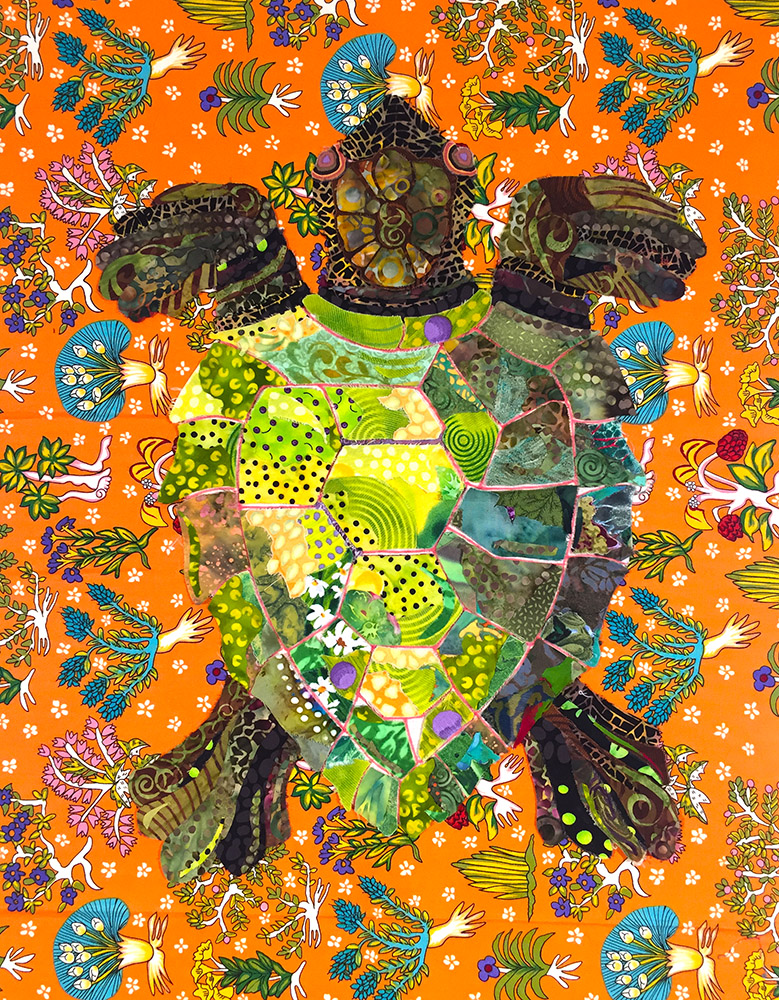
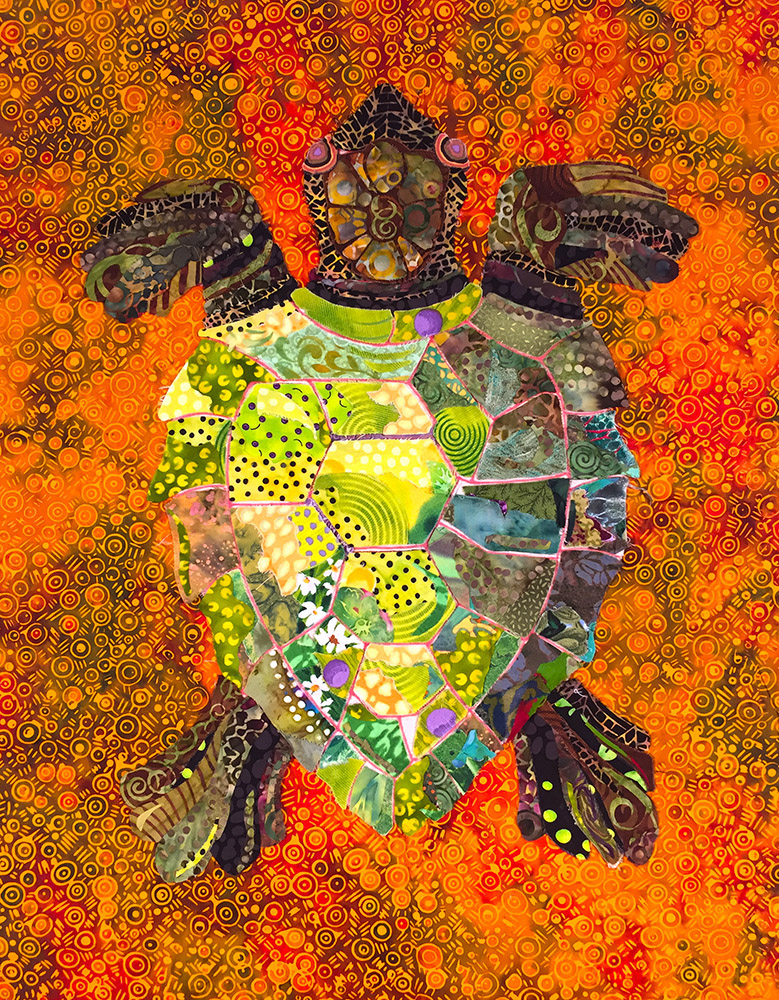
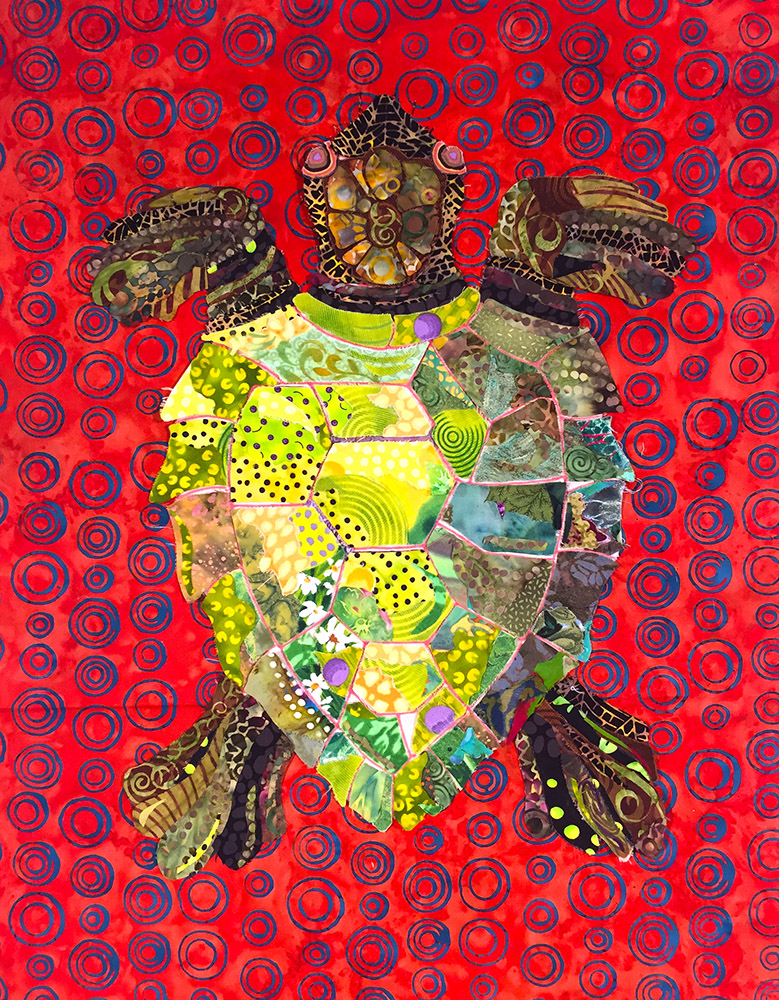
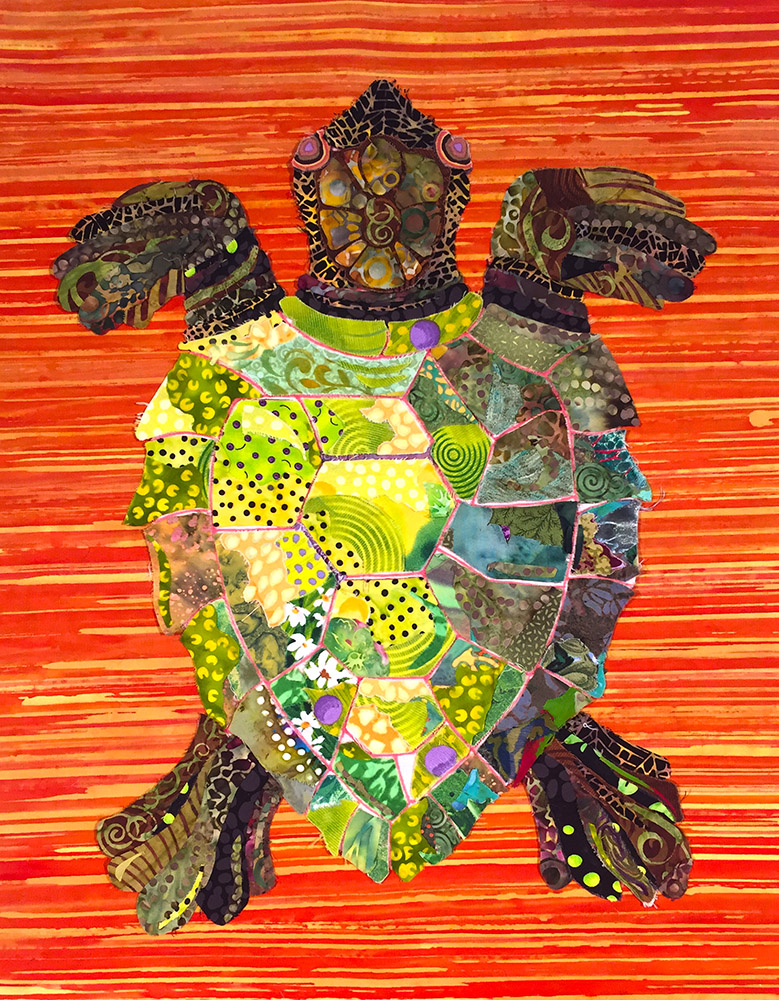
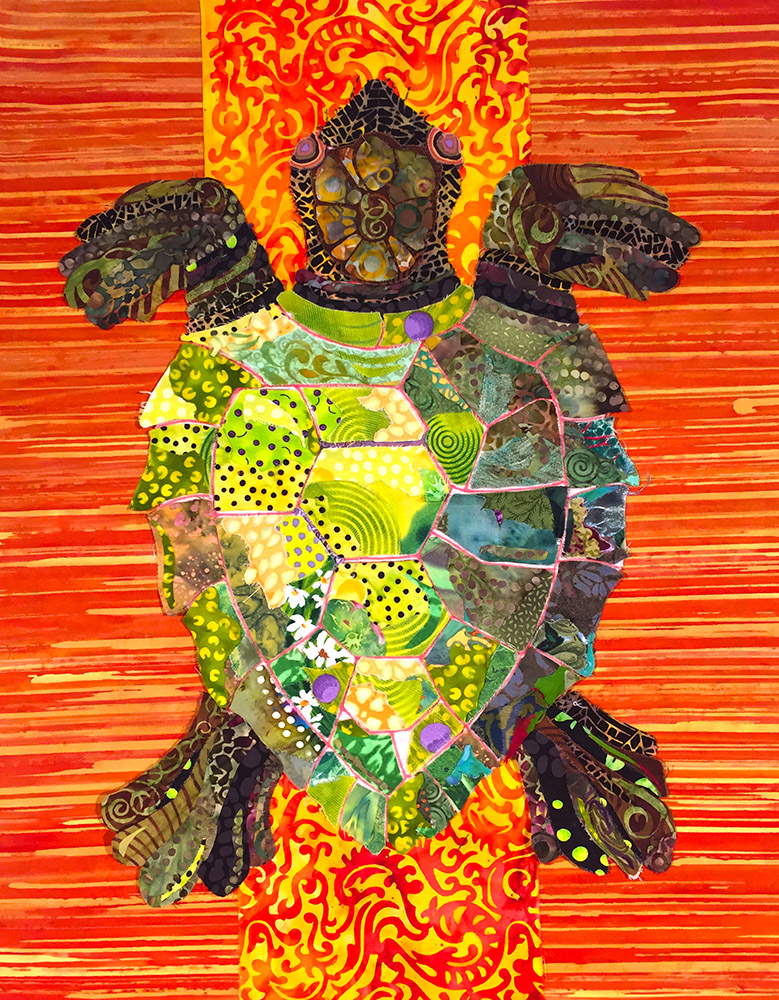
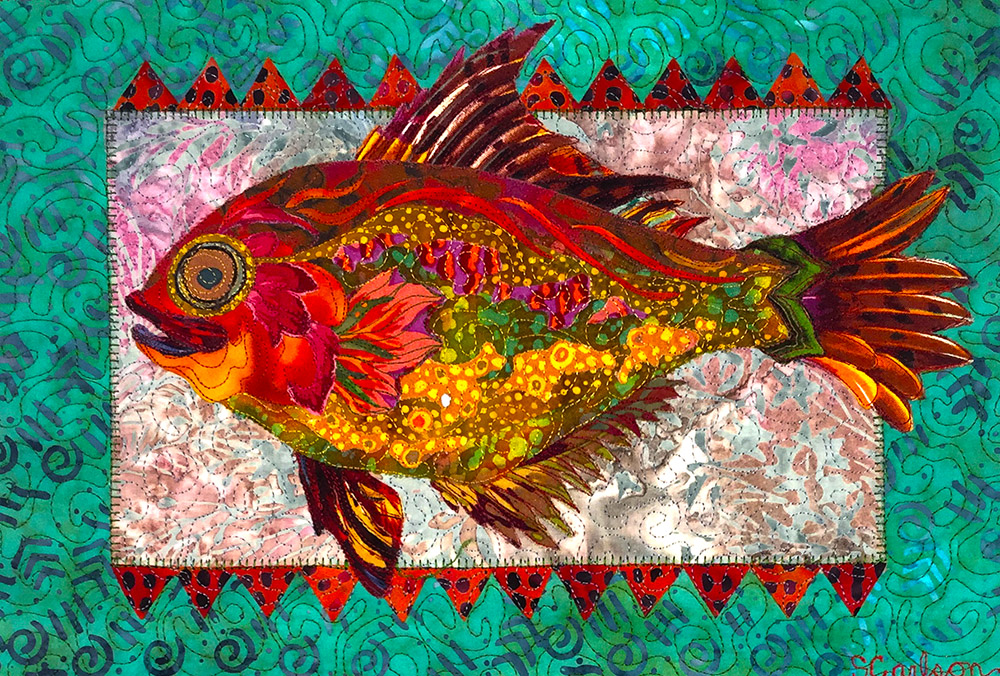



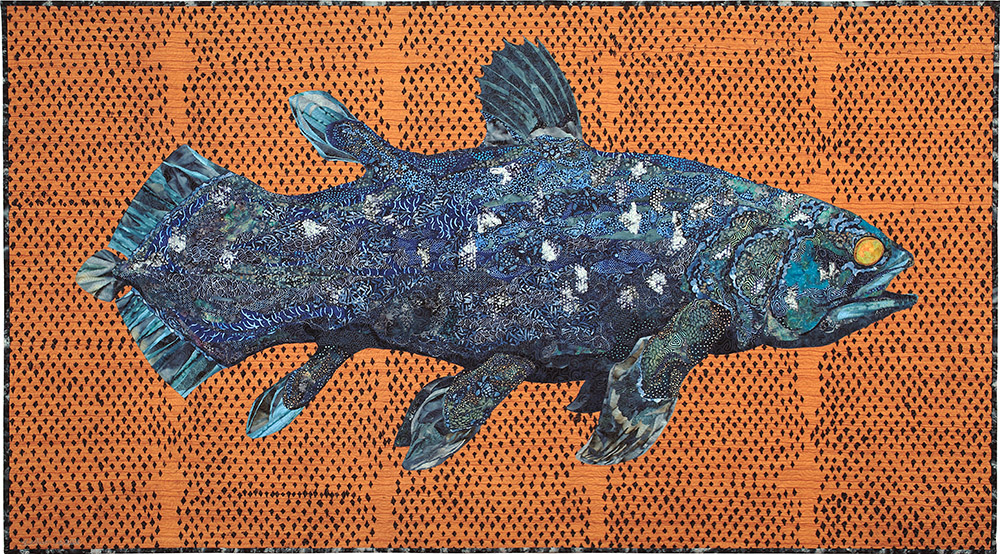


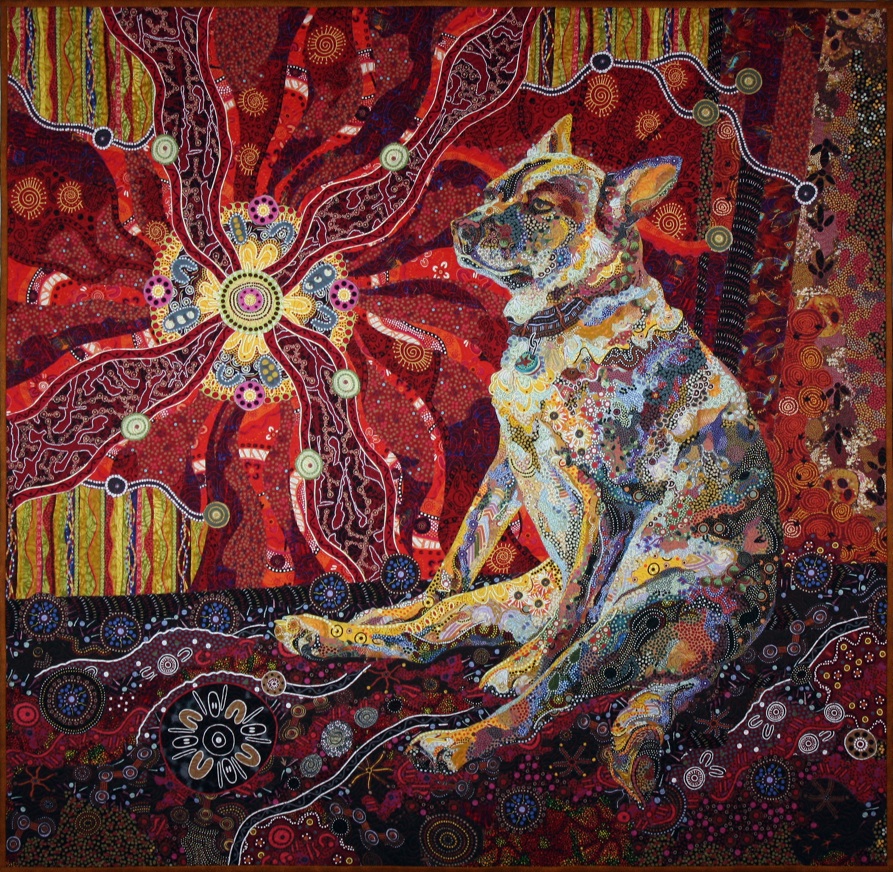
Susan: I love these posts that focus on the “how” of doing the quilts, and I agree that you need to know the “story” of the quilt to choose it in some cases. The video is great, too. I hope to get back to another Susan Carlson retreat before long. I just posted a blog about my second collage quilt since the June retreat, my Cocky Collared Lizard. Very different from Emily’s Smile.
Hi Jerri, nice to hear from you! I’ll have to check out that lizard – the name is intriguing – and I’ll look forward to that return visit of yours, whenever it may be.
Thank you for sharing your process, Susan.
You’re welcome, Mary.
I just want to say thank you!!!!! It is always inspiring and encouraging. I appreciate all the teaching you do online. Love seeing the close up images.
Hi Christina – I always enjoy seeing you and yours on Facebook – you were a good student, and I’m glad you enjoy these posts so much!
I was in Houston and saw your Specimens show. It is wonderful! I was thrilled to hear it would be there this year. The unexpected was the sparkles here and there, most noticeable on Stevie. This doesn’t show up in the photos. It was neat to see under the bright show lights. Just enough that I drew me in to look closer. I love it.
Thanks Sharyn, I’m glad you got to see the show in Houston. You weren’t the only one surprised by the glitz, others comment on that too!
What a gift that you share all this info with us! Thank you, Susan.
Once again Susan, I am eternally grateful for your generosity as you share your process in detail. I have made several fabric collage quilts following your process and have struggled with background choices. As a result, I tend to default to whole cloth–and am never quite satisfied with the result. You’ve now provided a way to think about making background decisions that makes sense. Thank you sooooo much!
One more thing I’m grateful for–after not receiving your weekly blog posts in my feed for several Saturdays ina row, I was concerned that something had happened to you. This morning I decided to do a Google search and discovered your new website had gone live and your blog posts were on a different url. I’m now back in business (AWESOME!) and looking forward to future informative blog posts.
Thank you. The five questions will be invaluable to me on my latest project and into the future.
This week’s blog is an early Christmas gift.
I love your quilts and really enjoy learning about the process. Reading your blog, coffee in hand, is a great way to start my Saturdays. Thanks!
Susan,
Thank you for the background information. I have trouble with them. On my coyote quilt, the judges said that it “lacked definition of the coyote”. I created the background to look like the original photo with dirt around the coyotes. I guess the fabric choices were too “blendy”.
Even your instructional descriptions read like stories. You are truly a master of “the story” in all of its forms. I feel honored that you share so much with us.
Thank you very much for your generosity in sharing your collage composition processes. I am learning so much…wish I could take a class from you….
For the turtle on the orange/yellow, I would try making the curves at top extend to the left corner and the curves at the bottom extend to the right corner, both enclosing the legs there? Just a thought.
Susan, this is another great post of information! Thank you for taking the time, I so appreciate it. Thank you so much!!
It is so helpful to hear your thought process, a peek into true creativity!
Good Evening,
I just found you while looking for something else. I am dying to try fabric collage. Do you have a basic how-to? Or, know of any books, videos that could help. I love the way you write and explain, so I’m really hoping you have something you’ve done. I look forward to hearing from you.
Sincerely,
Cathy Rae
Cathy. The place to start is with the blog itself. Try using the categories in the menu on the side (or at bottom on mobile). Choose “How To” which will then list all the posts that cover an aspect of the technique.
I can’t believe how skilled and talented an artist and quilter you are. Your work just stands miles above what we aspire to. Thanks for sharing your talent in such a positive way and creating a new crowd of expressive quilters.
Susan;
This refresher on choosing backgrounds is exactly what I needed, because I had hit a wall.
Choosing a proper background for the moose head and upper body I created at Downsivlle, WI in November, 2019 has led to much indecision as to how to proceed . I will now attack the background problem head-on, keeping in mind the questions you ask to guide the choices. Thank you for the redirection as I move into the next phase.
What a special treat it was this morning to hear your voice swirling around in my head as I was staring into my latest collage. I had embarked on a challenge with two of my friends and found myself doing an architectural piece ( which was out of the box for me). Your advice today was perfectly timed as I am contemplating the background without defaulting to the simplified solution. Thank you, thank you, thank you❣️I now have formed some great ideas.
Good morning Joanne! Glad for the timing and that my voice was swirling around in your head in a good way. 😉 Love to see that architectural collage sometime, maybe in a Finish Line post? And how about those turtles?